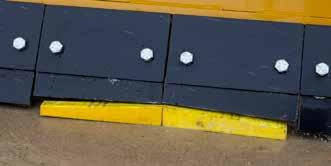
4 minute read
Putting your best foot forward
Putting your best foot forward Winning evidence on summary judgment motions
Asummary judgment motion can be a great way to dispose of a meritless claim. To succeed on such a motion, a defendant must establish that there is no genuine issue requiring a trial. However, the court has recently become more and more reluctant to even allow a defendant to schedule a summary judgment motion unless there is clear evidence that there is no genuine issue requiring a trial. This is even more so in slip and fall cases, which often involve issues of credibility.
Despite this reluctance, one can still bring these motions, but should do so with solid persuasive evidence in slip and fall cases involving snow or ice. A review of recent case law indicates that courts rely on the following types of evidence in considering whether an action should be summarily dismissed:
• The timing of sanding/salting/ plowing; • A reasonable system backed up by a detailed log; and • Industry standards.
The decision of Hannam v Medicine Hat School Division 76, [2018] AWLD 1783 provides an example of how timing can be persuasive evidence. In that case, Master Robertson granted the defendant’s motion for summary judgment even though the maintenance policy was not followed perfectly. The plaintiff slipped and fell while the contractor was still sanding.
The maintenance policy provided that sanding was to begin at 7:00 a.m. The contractor had not begun sanding until 8:00 a.m, and the incident happened at 8:45 a.m. In granting summary judgment, Master Robertson noted that the standard set out in the Occupiers’ Liability Act is one of reasonableness not perfection. The timing of the sanding was reasonable, and the plaintiff’s case was dismissed. This indicates that evidence regarding the timing of winter maintenance is an important factor in determining reasonableness.
A detailed log created at the time the work was done can be crucial to a successful summary judgment motion. In Shweihat v Greti Development Co. Limited, 2015 ONSC 5186, the defendant contractor was hired by the property owner to remove all ice from a parking lot. There was upwards of six inches of ice in places, and the contractor was required to supply their own manpower and tools to get it done promptly. This was not done, and the plaintiff slipped on ice.
In dismissing the defendant contractor’s motion for summary judgment, Justice Nightingale noted that he placed little weight on the evidence provided by the defendant’s log book as the contractor admitted on cross-examination that he created the log notes only after he was notified of the plaintiff’s claim. This case emphasizes that logs should be created contemporaneously, and with sufficient detail to be useful.
Finally, evidence regarding industry standards can be useful in determining whether a defendant has met the relevant standard of care. In Reichert v Home Depot Canada Inc., 2017 ABQB 184, the defendants were successful in having the action against them dismissed. The plaintiff slipped and fell on snow and ice while walking into a Home Depot, and sued both Home Depot and Bradbosh Landscaping Services. Home Depot and Bradbosh had entered into a winter maintenance contract which prohibited Bradbosh from removing less than two inches of snow from the parking lot. This requirement was based on industry standards. The plaintiff’s undisputed evidence was that he fell on a thin layer of snow, which was less than an inch thick. Based on the plaintiff’s version of events, and the defendant’s evidence regarding industry standards, Master Prowse found that “The present case is an example of a situation where there was no failure to take reasonable care, but unfortunately, an injury occurred nevertheless” and he dismissed the case.
What these three cases demonstrate is that to succeed on a summary judgment motion, a defendant must have strong evidence of what was done, what industry dictates be done, and what is reasonable. Without this evidence, a court will not have sufficient grounds to dismiss a plaintiff’s case, and defence counsel will find themselves in a difficult position.
What this means for those in the snow removal industry is that there should be an emphasis on keeping detailed, contemporaneous logbooks of whatever work is done. There should also be a general knowledge of what industry standards are and those standards should be reflected in maintenance contracts. These simple steps can make all the difference down the road. •
MAXIMIZE CONTACT CLEAR SNOW
Ride the Edge
HLA’s EdgeFlex takes a ground up approach to clearing snow. The segmented cutting edge provides the necessary adaptability to maintain consistent contact over uneven surfaces, common with aging infrastructure.
With maximum contact the mouldboard transfers its weight evenly across the cutting edge. The even distribution of force protects the surface from the potential damage of conventional blades when they scrape over high spots.
Plowing with an EdgeFlex is easy; just lay the blade down and run. While you worry about blade placement and controlling the direction of the flowing snow, HLA’s EdgeFlex technology works its way across the surface, adapting to the contours for cleaner results.
5°
5° Tilt
Each section tilts 5° in either direction to easily adapt to uneven surfaces.
1.5”

1.5” Vertical Lift
Each EdgeFlex section is able to move up 1.5”, ensuring the necessary contact when moving over uneven terrain.
www.hlasnow.com 1.866.567.4162 For warranty details, contact HLA Snow.










